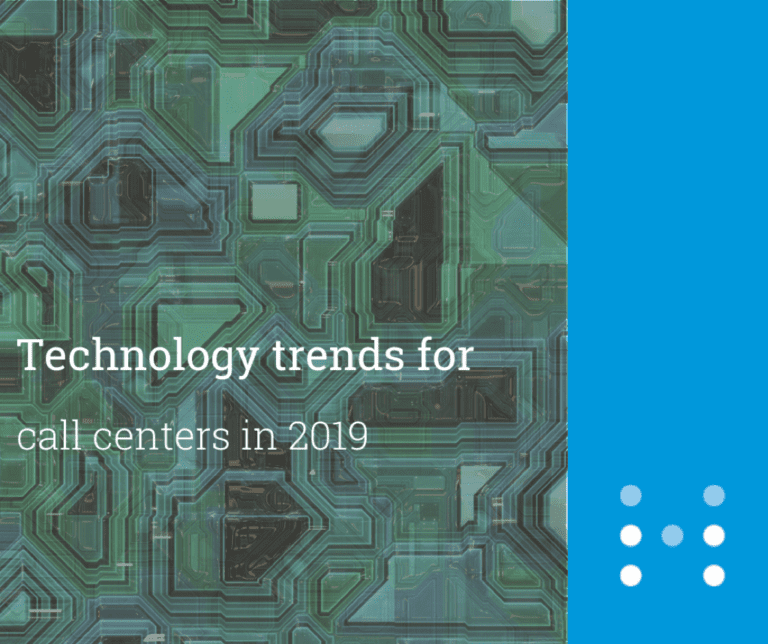Technology trends for call centers in 2019
In the past few years we’ve seen some impressive leaps in technology for call centers. Some of these leaps have completely revolutionized the way companies manage their contact centers. In 2019, there are some new trends on the rise, along with some improvements to last year’s.
1. AI is still on the rise
No surprises here as artificial intelligence continues to permeate nearly every technological landscape. Call centers are nothing different. As a matter of fact, the repetitive nature of call centers make AI a perfect tool for understanding the objectives of a customer when they are reaching out.
There has been much speculation as to the use of AI in call centers — mostly revolving around the fear of losing jobs or even the human touch. As we’ve said before, customer service takes empathy, and AI hasn’t learned that quite yet.
But the truth is, AI shouldn’t scare your team — it should be empower them. It isn’t simply a system one can put in place that magically takes the place of agents, it’s a tool that can be used to better understand a customer’s needs. Also, with the right algorithm in place, it can resolve a customer’s issue in minutes, leaving them with a positive customer experience.
According to Mikhail Naumov, co-founder and president of DigitalGenius:
The amount of time and effort that can be handled by artificial intelligence is massive, and equipping your team with the right tools can absolutely revolutionize your customer experience.
2. Omni-channel for all
One of the biggest trends of the past few years has been the omni-channel approach to customer service and experience. If you’re not on board now, you need to be.
The omni-channel approach has proven to be the way of the future as the many new ways to communicate with customers expand and make their experience more convenient. Meeting a customer’s needs where they are at provides a more intimate, personal touch to customer care — improving your rapport and trust with the consumer.
Understanding the interconnectedness of the customer journey at every step and every touchpoint is the backbone of an omni-channel strategy. The customer should be able to seamlessly traverse every aspect of their personal journey without being bogged down by silos in operations and processes.
3. Getting on the cloud
According to Global market intelligence firm, International Data Corporation, by 2020…67% of enterprise infrastructure and software spending will be for cloud-based offerings.
This is nothing new. As a matter of fact, the cloud wave has been here for years. According to Forbes:
“In 2016, small businesses spent over $55 billion on these cloud-based services, with the average professional using between 10-16 apps daily. By 2020, nearly 80% of small businesses are projected to use cloud-based services, increasing the current total by 37%.”
But why? Below are some of the top reasons why cloud based software is the only way for the future.
- Installing cloud-based call center software is typically just as simple as installing an app on a computer. No assembly required, and works right out of the box.
- Agents can work remotely and are able to access their session from wherever there is an internet connection.
- Cloud-based call centers software is easier to scale and customize. This is especially important because of the wavering seasonal activity, making it simple to add or remove users.
- Less reliance on hardware (other than strong internet connection).
- Better live call monitoring abilities — able to be accessed anywhere and anytime by a supervisor.
- More robust and diverse integration capabilities for CRM systems, helpdesk tickets, call script generators, survey templates, etc. with phone software.
- Integrated singular dashboards to keep all necessary data and initiatives in one place — able to be accessed anywhere at anytime.
These are just a few of the many benefits of cloud-based call center softwares. IT, security and protection are all factors that can be improved through the cloud. Not to mention environmental savings.
4. Continued social support
Having an active social media presence is no longer the status quo. Sure, memes are great and cat videos are probably never going out of style — but sharing content isn’t the only function of your business’s social media presence.
Customers that communicate with your social channels are looking for a response, therefore you must be equipped to handle two-way social media dialogues. Not only are they looking for a response, they’re looking for one quick.
Platforms such as Facebook and Twitter are a great place to engage with your customers, answer questions or even provide a response to a comment. An engaged social media presence shows that you care what your customers are expressing on their turf.
Social media is a great way to show your companies values and customer experience response out in public. This is especially true for negative feedback. Leaving negative comments without a response can leave a bad taste in consumer’s mouths. Don’t stray away from the bad, embrace it. This is your customer service team’s time to shine.
Resolving a complaint or issue quickly and out in the open can show potential customers how much you care about their issues — and this can do wonders for your business.
5. Customizability
What good is technology if it puts you in a box?
Being restricted by software or API’s is a roadblock that you simply can’t afford in your call center during 2019. Having the ability to forge custom solutions and experiences for your customers is how you will set yourself apart from the competition. Leagues apart.
Finding the right partner to help you create the very best infrastructure and technology available to create a frictionless customer experience is golden. Single vendor solutions can limit your potential and put barriers around your ability to scale and provide exceptional service.
Customizable solutions allow you the freedom to find the right fit for your sector or niche.
6. Better reporting and satisfaction metrics
Every business should be implementing some sort of customer satisfaction metric, that is a given. But one of the biggest mistakes we see today is the siloes these metrics come from.
There is no better way to understand how well you are implementing a customer experience strategy than hearing from the customers themselves. But, there are a myriad of ways and channels that customers can provide such feedback — and gathering all of that information takes innovation.
Handling the customer experience across digital platforms takes a steady, but firm hand. Without the proper omni-channel approach we mentioned earlier, some metrics can fall by the wayside — leaving you with an incomplete picture of success.
This is just a snapshot of the many ways you can take on 2019. The trends that we’ll be seeing will certainly shift and new practices will sprout up — but the practices we’ve listed are a surefire start to success in the new year.
Technology is an incredible tool, but without the proper implementation — it is wasted. Utilizing all of the tools you have and learning about ones to come is essential for future success.



